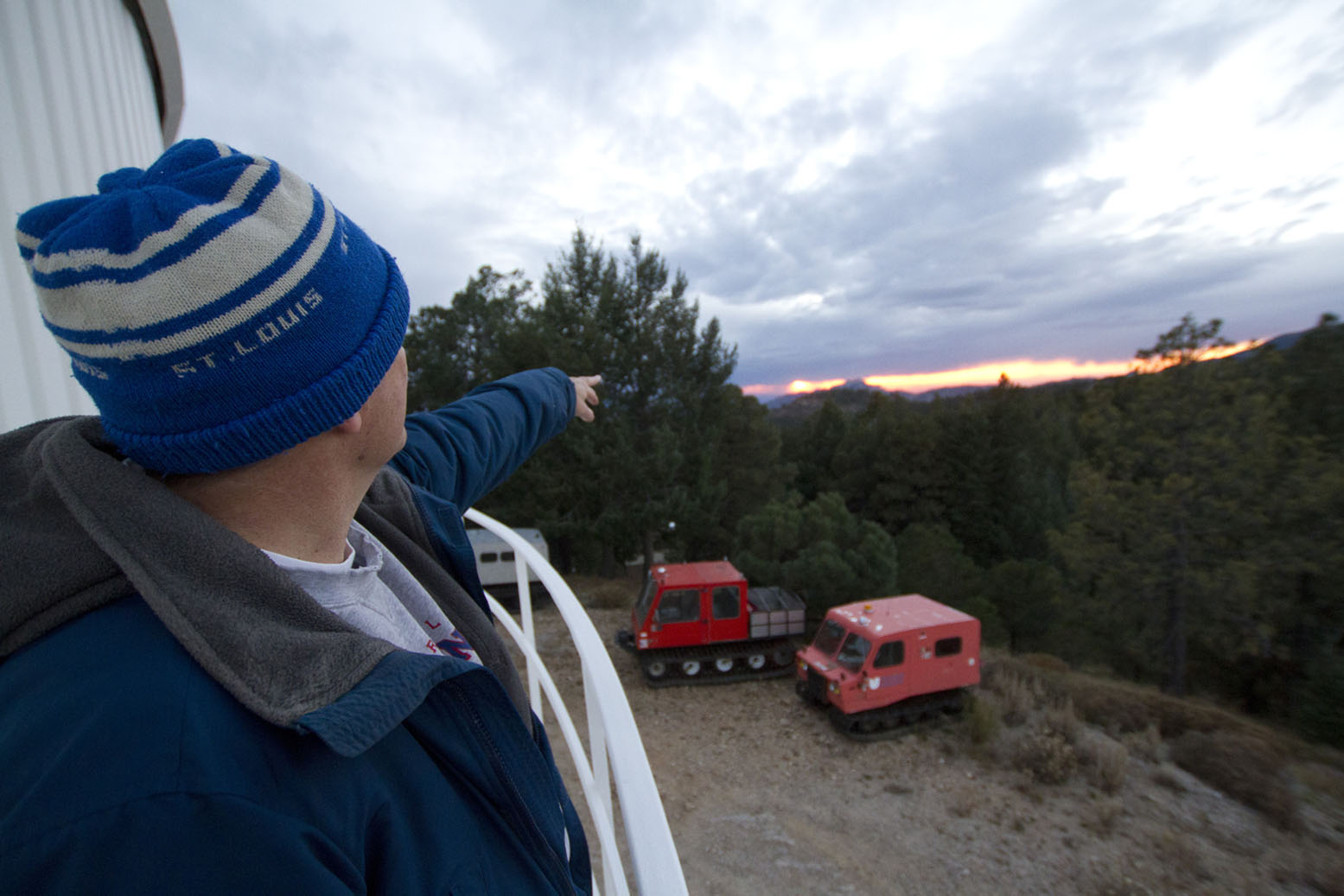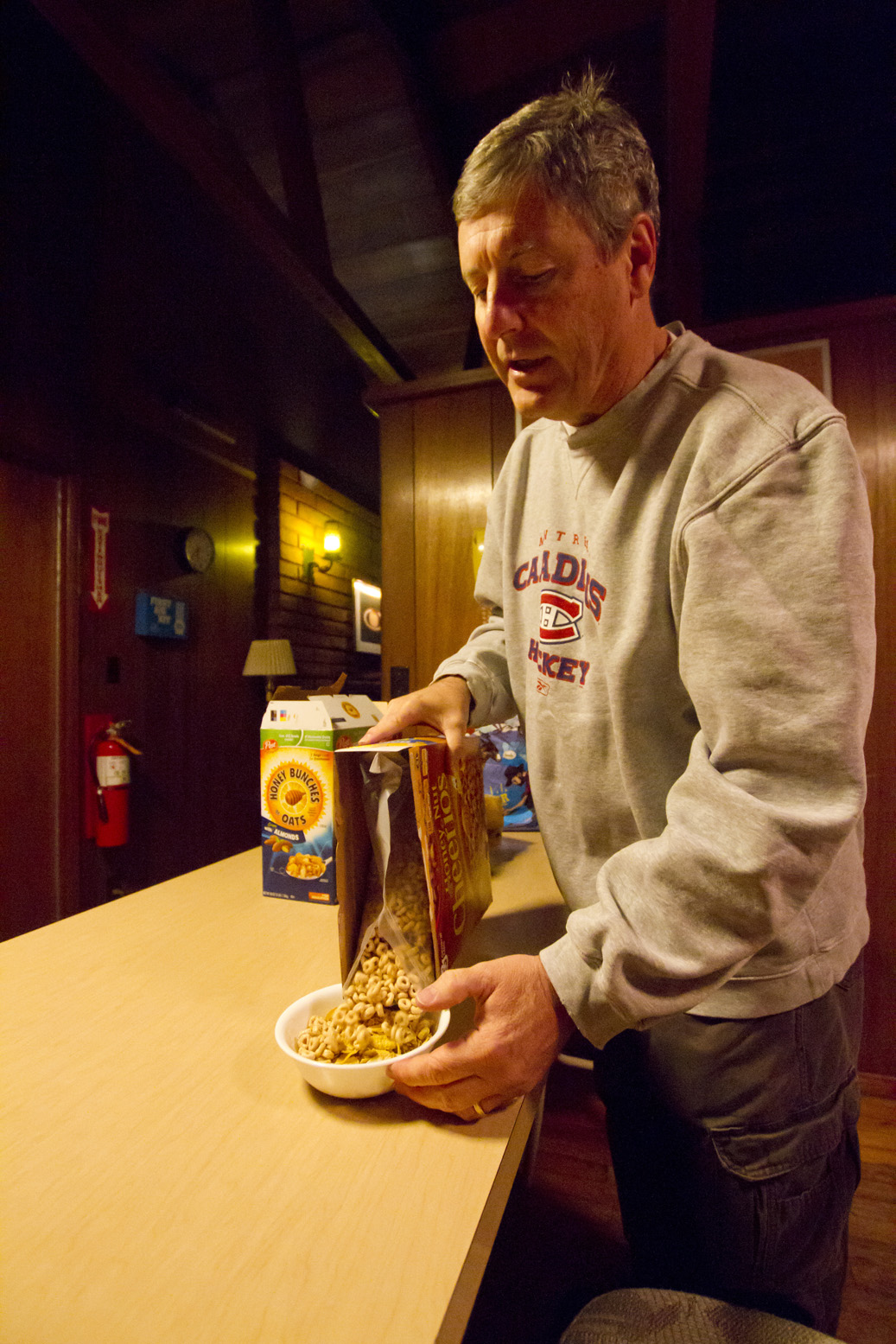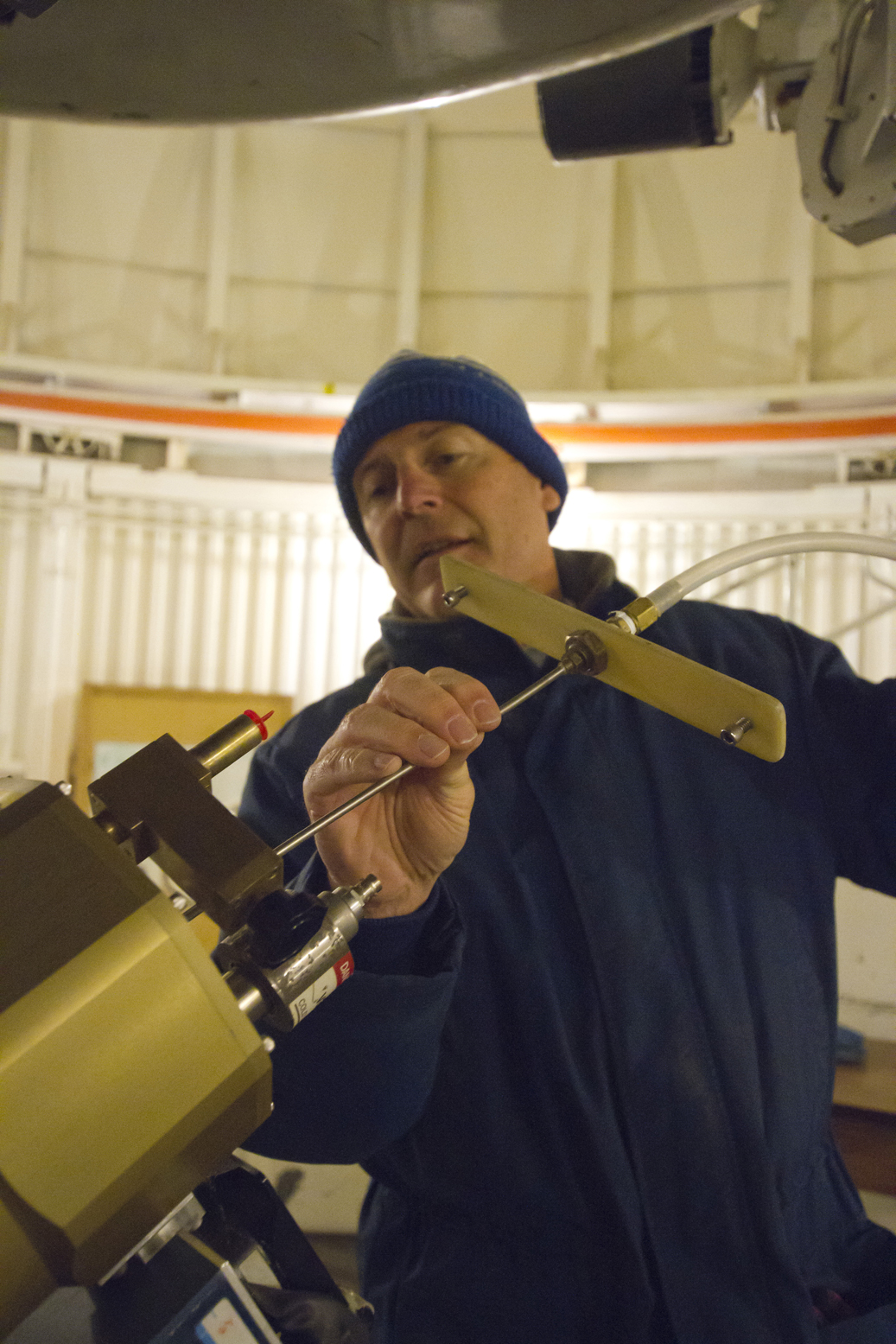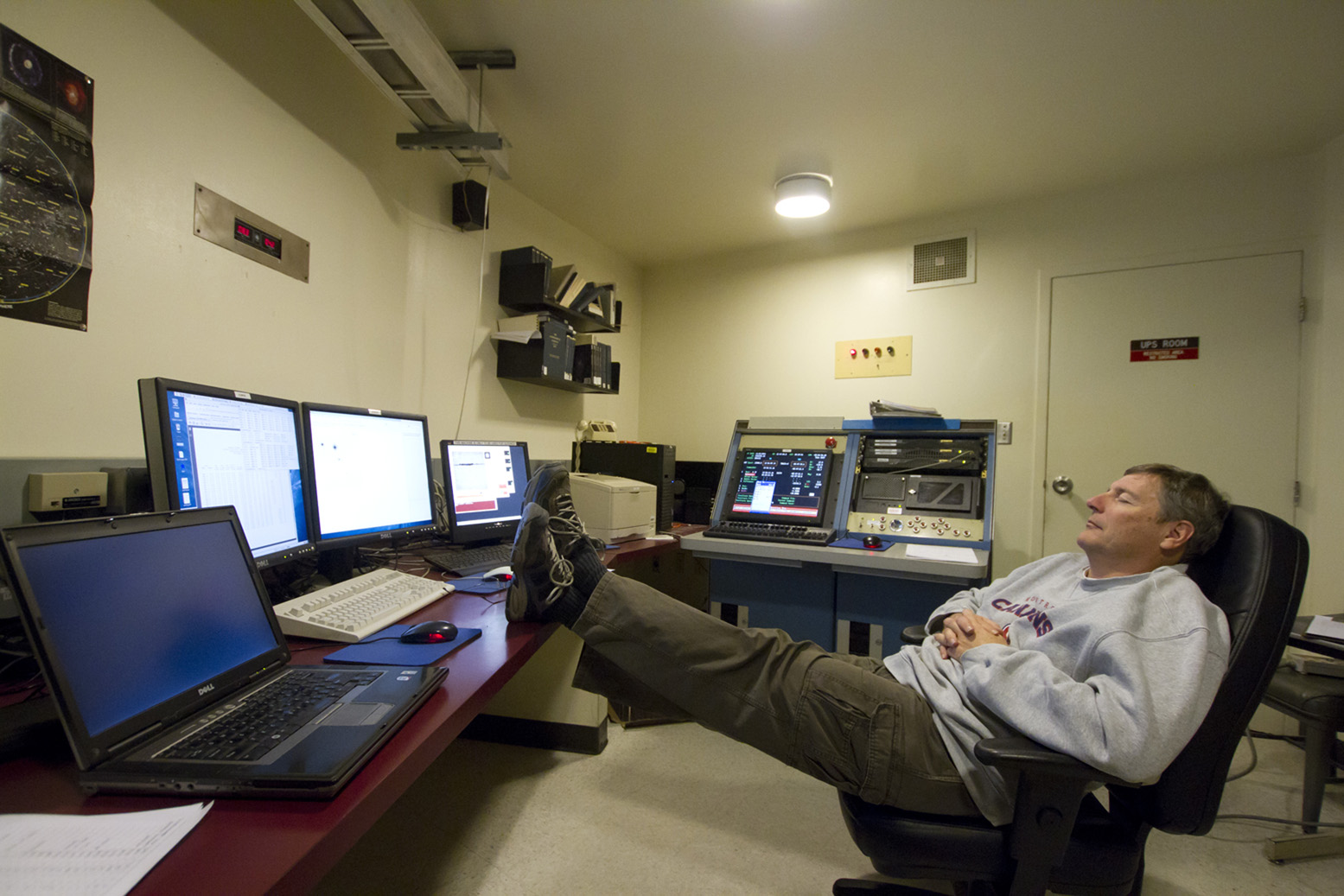
At 1 a.m., Paul Smith might be the only one playing Bach’s Brandenburg Concerto No. 1 at nearly full volume on Mount Lemmon.The piece has a happier tone than the 19th-century Russian and German composers he usually has playing through his iPod — a perfect soundtrack for the two PB&Js on wheat that he’ll scarf down as his final meal.
“It’s difficult to eat meals to the heaviness of Shostakovich,” he says with a chuckle.
It’s Friday night, and Smith is entering the middle of his second of nine nights at the Kuiper 61-inch, a telescope atop Mount Bigelow in the Santa Catalinas.
Outside, campers brave the 30-degree temperatures. Their fires roar nearby. The only sounds come from the whirring of the dome as the telescope makes its adjustments.
Inside, Smith has just collected the gamma ray emissions from a black hole estimated to be 4 billion light years away. The music is blaring over the speakers in the control room.
With a beep, one of the six computer monitors Smith is using flashes up a graph. A curve rises and falls across the chart, likely incomprehensible to anyone without an advanced science degree.
Smith scoffs.
“Well that’s a fairly boring spectrum,” he says.
An astronomer with the UA’s Steward Observatory, Smith is one of the many researchers who spend several days a month living in the dark.
A $150,000 instrument attached to the telescope serves as Smith’s eyepiece, transmitting images and data to the computer in the control room below. The image Smith is looking at is a fuzzy, gray screen.
Stars in neighboring galaxies show up as bright white circles. The duller patches of white are the quasars, blazars, asteroids and supernovae — objects Smith is looking for, often millions or billions times larger than the sun. Once he finds them, he’ll look at their gamma ray emissions, and study the polarizations.
“I don’t spend a lot of time looking at pretty sites,” he says. “In fact most of the data I collect is pretty mundane.”
Smith’s primary work supports NASA’s mission with the Fermi Gamma-ray Space Telescope, which launched in 2008. His additional projects also have him gathering data on asteroids and supernovae for articles to be written by other researchers.
He admits that his work does not yet have an application for the real world — not like the work of other UA astronomers who, for example, study the surfaces of asteroids to see what their impact on Earth could do to the planet. Still, Smith says the work he’s doing today will likely answer questions at some point down the road.
“There might be no application now, but we’re finding out why these things do what they do,” Smith says. “I think there’s room for those inquiries.”
Smith’s boss agrees. Buell Jannuzi, director for the Steward Observatory, suggested Smith become involved with the Fermi telescope project years ago.
“Polarimetry requires very skilled and competent observers and Paul is one of the best that I know,” Jannuzi said. “We are learning more about the laws of physics that influence and govern the universe we live in and so in that sense it satisfies a very basic desire for all of us to understand the universe in which we live and how we relate to it.”
Either way, Smith is happy to watch the skies.
As the quintessential space geek, Smith, 57, was born months after the launch of Sputnik and grew up during the Space Race. “2001: A Space Odyssey,” Stanley Kubrick’s 1968 epic that revolutionized sci-fi film, has been Smith’s favorite movie since he saw it when he was 11.
A Rochester, N.Y., native, he studied physics at St. Louis University before pursuing a doctorate at the University of New Mexico for the same degree. Steward Observatory hired him in 1986, right after graduation, to help craft an instrument that now collects data from the Hubble Space Telescope.
He rubbed elbows with Neil deGrasse Tyson at a 1986 astronomer’s convention in Houston when both were graduate students. He’s also shaken the hand of Kip Thorne, whose research has provided the foremost theories on black holes.
Through all these experiences, the passion he’s had for stargazing since he was a kid has never faltered.
“Most kids grow out of such a phase,” he says. “I never did.”
Smith spends nine nights every month staring at the quasars, blazars, asteroids and supernovae that have long since died off, but whose light still reaches Earth. His research, he says, coincides with his love for classical music.
“I listen to dead composers and look at objects that no longer exist,” he says facetiously from the control room.
Thanks to his dedication to a number of various projects, Smith’s observing schedule is far more rigorous than most astronomers’. His wife, Laurie, a nurse practitioner who also works a busy schedule, says finding time for vacations can be difficult even though they don’t have any children.
This year, Smith observed over Thanksgiving and will again over Christmas, coinciding with the new moon, which provides the darkest skies. Laurie Smith said she plans to spend the holidays with her own family, and probably won’t go to the trouble of cooking.
Still, she laughs at the quirks her husband’s career brings.
“The funniest thing that most people think is amusing is that all our travel has to be planned around the full moon,” she says. “We can only go out of town on a full moon because he’s observing on a new moon.”
Even with the struggles, Laurie Smith says she’s never questioned her husband’s dedication to his career.
“He’s one of those rare individuals that knew what he wanted to do when he was very young,” she says. “He doesn’t understand how people struggle to figure out what they want to be in their lives. It’s so nice that he gets to do what he wants to do.”
By 5 a.m., Smith’s eyelids are falling as he sneaks short snoozes between the beeps of the computer. Twilight casts a blue tinge through the Rocky Mountain maples, corrupting Smith’s data with light pollution as he squeezes in a few more observations.
By 6, he calls it a night.
With so much time spent all at once on a mountain in nearly complete solitude, Smith says he struggles to get through the last two nights of every round of observing. The music helps.
Still, something keeps him coming back.
“It’s really hard for me to delineate between my job and my hobby,” Smith says, his sarcastic nature shining through the fatigue. “Something about going to telescopes has kept me motivated all these years. The question being, is it pathological?”
—
Kyle Mittan is a reporter at Arizona Sonora News, a service from the School of Journalism at the University of Arizona. Contact him at kyle.mittan@email.arizona.edu







